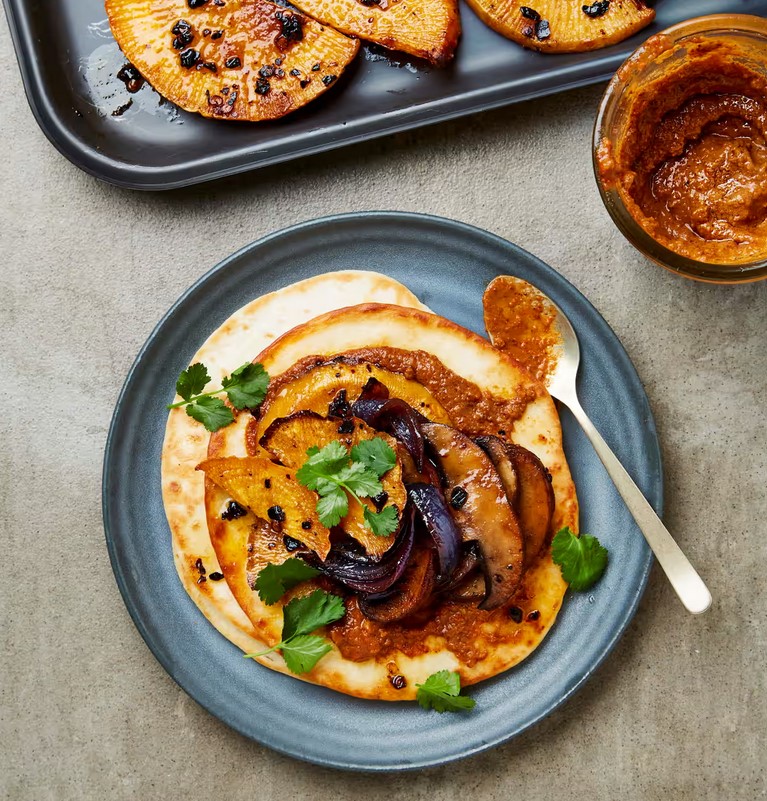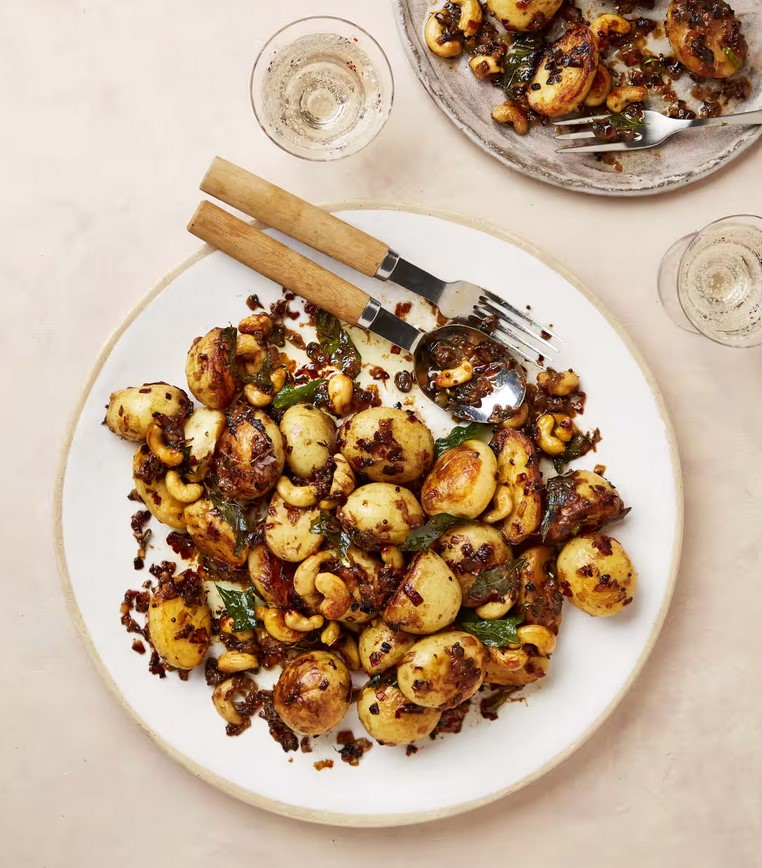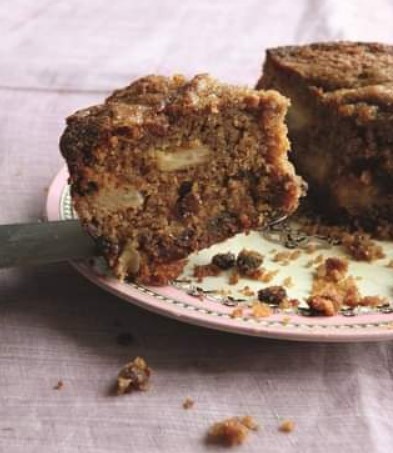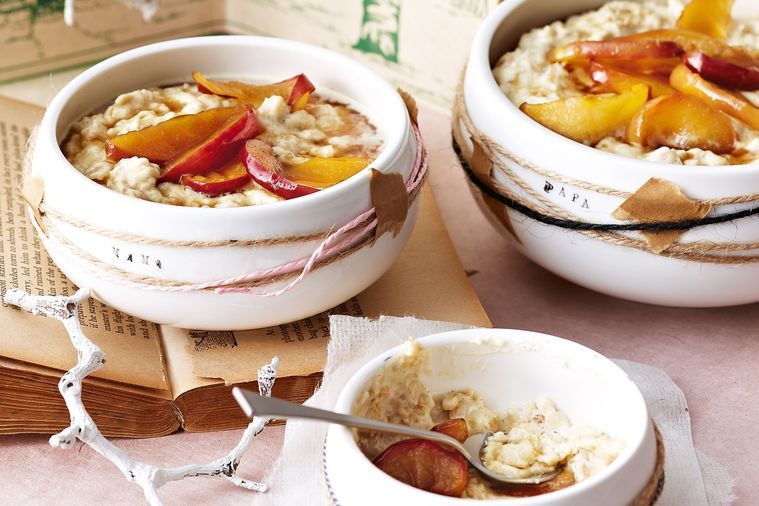Rebecca’s Recipe of the Week: Swede (and Mushroom) Flatbreads with Peanut Salsa
One of the benefits of our current mode of living is that we can eat messily, enjoying the pleasure of sticky, savoury foods that we hold with our fingers. These drippy, delicious flatbreads are fun to make and fun to eat. And who would have guessed that swede, spiced with Mexican chiles and accompanied by a peanut salsa, would taste so perfect wrapped in a tortilla?
I made these without the mushrooms and they were excellent but doubtless they’ll be delicious with them, too. I also augmented Meera’s original recipe with some sautéed dandelion greens. Fresh dandelions are beginning to appear in the woods and verges, waiting for you to pick them, but you could also use spinach or another leafy green.
Swede (and Mushroom) Flatbreads with Peanut Salsa
Serves 4

Ingredients
For the Roast Vegetables
5 tablespoons rapeseed oil
1 tablespoon ancho chile flakes (or another mild dried chile)
½ tablespoon chipotle chile flakes
¼ teaspoon ground cloves
½ teaspoon ground cumin
1 teaspoon salt
800g swede, peeled, cut in half, and then sliced into 1cm half-moons
1 large red onion, peeled, cut in half, and then sliced into 1cm half-moons
300g large mushrooms, cut into 1cm slices (optional)
For the Peanut Salsa
75ml rapeseed oil
5 fat garlic cloves, peeled
100g salted roasted peanuts
½ tablespoon chipotle chile flakes
¼ teaspoon salt
1 tablespoon cider vinegar
100ml water
For the Sauteed Greens
splash of rapeseed oil
250g dandelion greens (or spinach, or really any other leafy green)
To serve
tortillas or other flatbread
handful of coriander, chopped
plain yoghurt
Preparation
Prepare the Roast Vegetables: Heat the oven to 200C. While it heats up, mix together in a small bowl the 5 tablespoons rapeseed oil, ancho chiles, ½ tablespoon chipotle chiles, cloves, cumin and salt. Place the swede and onions in a large bowl. Put the mushrooms (if you’re using them) in another bowl. Divide the spiced oil between the two bowls and toss with your hands to distribute the oil over the vegetables. Put the swede and onions into a roasting tin and roast for 10 minutes. Then add the mushrooms (if used) and roast everything for about 20 more minutes. Check partway through to make sure they’re not burning, and to turn over the swede slices, so that each side gets pleasantly browned. Once the vegetables are soft and caramelised they’re ready to eat.
Make the Salsa: put 75ml of rapeseed oil, garlic, and peanuts in a small saucepan. Heat over a low flame and bring slowly to a boil. Simmer over the lowest possible heat for 4-5 minutes, or until the garlic starts to colour. Remove from the heat and add the ½ tablespoon chipotle chile flakes and salt. Once it is cool, add the vinegar and water and whizz up in a blender until it is semi-smooth, or at least as smooth as you like. A little chunkiness is pleasant.
Sauté the Greens: Heat the oil in a frying pan. Once it’s hot add the greens and toss them about in the hot oil for a few minutes, until they wilt. (If you are using kale or a tougher green this will take a bit longer.) Dandelions are not only tasty but really quick to cook. . . In any case, once they’re done set them aside until you’re ready to eat.
Assemble the Flatbreads: warm your flatbreads in a dry frying pan. Once they are warm, spread each one with some of the peanut salsa and strew some of the greens on top. Spoon some of the roast vegetable over that, and top with a sprinkling of coriander. Bring to the table along with the yoghurt, so that you can drizzle a bit over the top if you like. Eat with your hands.
Recipe adapted from Meera Sodha, The Guardian, 20 March 2021.
Rebecca’s Recipe of the Week: Parsnips and Ginger
Here is another winter soup recipe from Hugh Fearnley-Whittingstall. Ginger and cayenne give a bit of a kick, while the parsnip provides a mellow, sustaining backdrop. Serve with some good bread.
Parsnip and Ginger Soup
Serves 4
Ingredients
1 tablespoon olive oil
15g butter
1 large onion, finely chopped
2 garlic cloves, finely chopped
4–5cm piece of ginger, peeled and finely chopped
¼ teaspoon ground cardamom
¼ teaspoon ground cumin
¼ teaspoon cayenne pepper
500g parsnips, peeled and cut into 1cm cubes
800ml vegetable stock
200ml whole milk
Sea salt and freshly ground black pepper (to garnish)
2–3 tablespoons flaked almonds or pumpkin seeds (to garnish)
1–2 tablespoons double cream or thick, plain (full-fat) yoghurt (to garnish)
Preparation
Heat the olive oil and butter in a saucepan over a medium-low heat and sauté the onion for about 10 minutes, until soft and translucent.
Add the garlic, ginger, cardamom, cumin and cayenne and stir for a couple of minutes. Tip in the parsnips and stir until well coated in the spices. Pour in the stock, season with salt and pepper and simmer until the parsnips are very soft – about 15 minutes.
Allow the soup to cool slightly, then purée in a food processor or blender, or using a stick blender, until smooth. Return the soup to the pan, add the milk and adjust the seasoning. Warm through gently – if the soup is a bit thick, thin it with some hot water from the kettle.
While the soup is warming, toast the almonds or pumpkin seeds in a dry frying pan until just beginning to turn golden.
Serve the soup in warmed bowls with a trickle of cream or yoghurt and the toasted almonds scattered over the top. Finish with a grinding of black pepper.
Recipe from Hugh Fearnley-Whittingstall, River Cottage Veg Every Day! (2011).
Rebecca’s Recipe of the Week: A Garlic Sauce that Improves Everything (Including Christmas Leftovers. . . )
This is a version of a Lebanese sauce called toum. Toum is essentially a eggless mayonnaise, in which the garlic magically emulsifies the oil to produce a thick, creamy sauce that is good on everything from roasted squash to chicken shawarma. You can also use it as a dip—or make a post-Christmas sandwich by spreading toum on some toast, and toping with avocado and leftover sliced turkey.
Traditional toum uses raw garlic; for this one you simmer the garlic in milk, which gives a mellower, more complex flavour.
Toum
serves 4
Just reminding you: 1 cup is 8 fluid ounces measured in a measuring jug, so half a cup is 4 fluid ounces…
Ingredients
½ cup peeled garlic cloves
1 cup whole milk
1 tablespoon lemon juice
½ teaspoon salt, or to taste
½ cup olive oil
pepper, to taste.
Preparation
Put the garlic cloves and milk in a small saucepan and bring to a boil, over low heat. Simmer over very low heat (you could use a heat diffuser if you have one) for between 40 and 90 minutes, or until the garlic is very tender and has absorbed much of the milk. Remove from the heat and leave to cool a bit.
Put the cooled garlic and milk in a blender along with the lemon juice and salt, and whizz it up.
Slowly drizzle in the olive oil, in a steady stream, until the sauce is thickened and looks for all the world like mayonnaise. Season to taste with additional salt, and perhaps some pepper if you wish. Drizzle over anything.
Recipe adapted from Ana Sortun and Maura Kilpatrick, Soframiz: Vibrant Middle Eastern Recipes from Sofra Bakery & Café (2016).
Rebecca’s Recipe of the Week: Meera Sodha’s Coconut-Tamarind Potatoes
This is a flavoursome dish that plays to the potato’s strength as a vehicle for strong flavours. Here your Canalside spuds combine with the richness of coconut milk and the sharp, sour tang of tamarind to deliver a punchy, satisfying dose of carbohydrates. Cashews and crispy onions contribute additional crunch. A sprinkling of green coriander over the top looks lovely and adds an additional freshness.
It is particularly good combined with the south Indian beetroot and coconut dip whose recipe I will provide in my next instalment.
Potatoes with Tamarind, Coconut and Cashews
Serves 4-6 as part of a larger spread.

Ingredients
1kg potatoes
3 tablespoons coconut oil
1 teaspoon black mustard seeds
1 teaspoon cumin seeds
10 fresh or frozen curry leaves
300g shallots, peeled and sliced fine—or you can use onion, really
3 garlic cloves, peeled and crushed
2cm piece of fresh ginger, peeled and grated
2 green chiles, finely chopped (take out the seeds if you prefer, and also adjust the quantity to taste)
100g cashew nuts
1 teaspoon salt
2 teaspoons tamarind paste
200ml coconut milk
a handful of coriander leaves, chopped, to garnish (optional)
Preparation
Put the potatoes in a pan and cover with cold water. Bring to a boil over low heat and cook gently until they are tender. How long this takes will depend on the size of the potatoes, so this process can last between 20 and 45 minutes. When the potatoes are tender drain them and set them aside. Once they are cook enough to handle cut them into bite-sized pieces. You can do this well in advance if you wish.
Combine the mustard seeds, cumin seeds and curry leaves in a little dish. Combine the garlic, ginger, chiles and cashews in another dish. You’re now all set to add each tranche of ingredients without having to fuss around with lots of separate items.
Put the oil in a large frying pan over medium heat. When it is hot add the mustard, cumin and curry leaves. Once the seeds start to sizzle add the shallots and cook, stirring, for about eight minutes, or until the shallots starts to brown.
Add the garlic, ginger, chiles and cashews to the pan. Cook, stirring regularly, for another two minutes. Now add the drained potatoes in a single layer and sprinkle with salt. Turn the heat to high and fry for about five minutes, stirring once, until the potatoes are turning an appetising brown. Don’t stir them constantly, or they won’t brown.
Finally, add the tamarind paste and the coconut milk. Leave to cook, stirring regularly, until the coconut milk has mostly evaporated and turned into a sticky glaze. Serve hot, cold or at room temperature. It looks nice garnished with some chopped fresh coriander.
Recipe adapted from Meera Sodha, The Guardian, 12 June 2021.
Rebecca’s Recipe of the Week: Pumpkin Hummus
This Ottolenghi-esque hummus is rich, smoky from star anise, and much lighter than your usual chickpea-only hummus. It is a good use of one of those rather large pumpkins, which can be a bit watery. The cinnamon combines well with the tahini, and enhances pumpkin’s (or squash’s) natural sweetness. If you like things even sweeter, you could drizzle this with a little maple syrup before serving. Eat on toast for a tasty and nourishing snack, or as part of a larger spread.
As regards the star anise, I actually used a fabulous home-made chile oil seasoned with star anise (made by my son!) which added both a kick and the crucial star anise flavour. I think roasting the pumpkin or squash with some ground star anise should be equally effective. Let me know how it works.
Pumpkin (or Squash) Hummus
serves 4 as part of a larger spread
Ingredients
500g pumpkin or squash, peeled (if you wish) and sliced (approximately 2cm thick)
1½ tablespoons olive oil
½ teaspoon cinnamon
1 star anise, pulverised (as much as possible) in a mortar and pestle or spice grinder
salt and pepper
1 400g tin of chickpeas, drained BUT reserve the liquid.
2 tablespoons full-fat yoghurt (Greek or ordinary)
2 tablespoons tahini
juice of one lemon (about 2½ tablespoons)
½-1 teaspoon Sriracha or chile oil (start with the smaller quantity and add more to taste)
2 garlic cloves, peeled
Preparation
Preheat your oven to 200C.
Place the pumpkin or squash in a roasting tray and toss with the olive oil, cinnamon, star anise, and some salt and pepper. Spread it out on the roasting tray in one layer and roast for about 25 minutes, or until it is tender when poked with a fork. Remove from the oven and let cool a few minutes.
Reserve one slice of pumpkin or squash and a handful of chickpeas for a garnish. Cut the reserved pumpkin or squash into bite-sized cubes and set aside.
Place the rest of the pumpkin or squash, chickpeas, yoghurt, tahini, lemon juice, Sriracha or chile oil, and garlic in a food processor and blend for several minutes, until smooth. If it seems too thick for your taste, add a bit of the reserved chickpea liquid.
Taste to see if you’d like more salt, pepper, lemon juice or heat, and adjust accordingly.
Transfer to an attractive blue serving bowl and garnish with the reserved chickpeas and pumpkin or squash and serve with toasted pitta or bread.
Recipe adapted from Ina Garten, Cooking for Jeffrey (2016).
Rebecca’s Recipe of the Week: Enough Already with the Apple Cakes!
This, I promise, will be the last apple cake, at least for 2021. Why all the cakes? Because each is so distinctive, and because there are a lot of apples about at present. This one is rich, buttery and deeply flavourful, the best of the lot, says Matt. Because it contains apples, raisins and marmalade, I think it qualifies as breakfast food.
Chunky Apple and Marmalade Cake
Hugh F-W claims this serves 8-10.

Ingredients
3 tablespoons whisky
100g raisins or sultanas
100g ground almonds
175g plain wholemeal flour
2 teaspoons baking powder
pinch of salt
3-4 large eating apples (about 500g in total)
200g butter, softened
200g soft dark brown or dark muscovado sugar
3 eggs
150g orange marmalade
25g demerara sugar (to sprinkle on the top)
Preparation
Preheat the oven to 170C. Butter a 20cm springform pan.
Warm the whisky in a small pan. When it is warm add the raisins or sultanas and leave them to soak while you prepare the cake. You could probably do this equally well using a microwave.
Combine the ground almonds, flour, baking powder and salt in a bowl and mix well to combine.
Peel the apples, if you wish, cut out the cores, and either slice into thick slices or cut into 1cm chunks. Set aside.
Beat the butter and sugar with an electric mixer for 5 minutes, or until it becomes fluffy and noticeably paler in colour. You want this to be light, not heavy at all, so give it time.
Add the eggs, one at a time. Add a spoonful of the flour mixture with each egg, and beat well after each addition.
Fold in the remaining flour.
Put the marmalade in a small bowl and stir it vigorously with a fork to loosen it, and then add it to the cake mixture.
Add the raisins, whisky and apples and turn the mixture into the cake pan.
Scatter the demerara sugar over the top and bake for about 1¼ hours, or until a cake tester comes out clean.
Leave the cake to cool in the tin for 15 minutes and then turn out and leave to cool on a rack.
Recipe adapted from Hugh Fearnley-Whittingstall, River Cottage Fruit Every Day! (2013).
Rebecca’s Recipe of the Week: An unusual Apple Cake
Here is a different sort of apple cake. Unlike the Apple Spice Cake of a fortnight ago, this one uses yeast. But don’t panic! It’s very easy and doesn’t require any kneading. The result is somewhere between a bread and a cake; it’s very moist, and is good toasted.
Using yeast to leaven a cake is an old practice. Before the invention of bicarbonate of soda and baking powder in the nineteenth century, eggs provided one way to create a light texture. Yeast was another. Many traditional English cakes were originally leavened with yeast. This loaf is heavier than a typical cake, but still crumbly—see what you think!
Apple Loaf – makes 1 large loaf
If you don’t have a set of cup measures, don’t worry. 1 cup = 8 fluid ounces, so you can use an ordinary measuring jug.
Ingredients
1 tablespoon dried yeast
¼ cup lukewarm water or apple juice
¼ cup vegetable oil
½ cup runny honey
2 eggs
¼ teaspoon salt
2 teaspoons cinnamon
½ teaspoon ground allspice
½ teaspoon nutmeg
1 teaspoon vanilla essence
1 tablespoon finely grated orange zest
2 cups wholewheat plain flour (use white flour, or a mixture, if you prefer)
2 cups apples, cut into small (¼-inch) pieces—fine to leave unpeeled
½ cup nuts, toasted in a dry pan and coarsely chopped (optional)
¼ cup raisins or chopped dates (optional)
Preparation
Oil a loaf pan and set it aside. In a small bowl, dissolve the yeast in the warm water or juice. Leave to one side for 5 minutes, or until it starts to bubble a bit. (If it doesn’t bubble, your yeast is probably dead.)
Combine the oil, honey, eggs, salt, spices, vanilla and zest in a large bowl and mix well. If you have stand mixer use it to beat the mixture for 5 minutes, for added lightness.
Stir in the yeasty water/juice.
Add the flour and stir well to combine.
Stir in the apples and optional nuts and raisins (if used).
Turn into the oiled loaf pan and leave to rise for 1-2 hours, or until about double. When it’s nearly there preheat the oven to 180C.
When the oven is hot put in the loaf and bake for 40-50 minutes, or until a cake tester emerges clean. Leave to cool and eat with butter for breakfast. It’s nice toasted.
Recipe adapted from Edward Espe Brown, The Tassajara Bread Book (1970).
Rebecca’s Recipe of the Week: Apple Spice Cake
This moist apple cake uses oil in place of butter, which makes it exceptionally tender and probably also lower in cholesterol. It offers a perfect autumnal blend of fresh apples, spices and walnuts, and is very nice with a cup of tea. It keeps very well, should you somehow not eat it all in the first 48 hours.
If you don’t have a set of cup measures, don’t worry. 1 cup = 8 fluid ounces, so you can use an ordinary measuring jug.
Ingredients
1¼ cups vegetable oil
2 cups brown sugar (any mix of soft brown sugar, light muscovado, and dark muscovado)
3 eggs
2 teaspoons vanilla extract
3 cups plain white flour, or 2 cups plain white flour and 1 cup plain wholemeal flour
1 teaspoon baking powder
1 teaspoon bicarbonate of soda
½ teaspoon salt
1 tablespoon ground cardamom
½ teaspoon cinnamon
1 tablespoon apple cider vinegar + 2 tablespoons water (or 3 tablespoons water)
3 cups chopped apples (peeled or not, as you prefer, cut into whatever sizes you’d like to find in your cake)
1 cup chopped walnuts (optional)
Preparation
Preheat the oven to 180C. Butter or oil a 10-inch Bundt pan, or similar tube pan. Coat the pan with a light dusting of flour and set aside.
In a large bowl, beat the oil and sugar for 5 minutes, or until thick. This is a good use of your stand mixer if you have one. Add the eggs one at a time, beating for a minute after adding each one. Add the vanilla.
In a separate bowl, combine the dry ingredients (flour, baking powder, bicarbonate of soda, salt and spices).
Add the dry ingredients to the wet mixture and beat until smooth. Stir in the apple cider vinegar and water.
Fold in the chopped apples and nuts.
Pour the batter into the pan and bake for an hour, or until the cake is golden brown, smells lovely, and is pulling away from the widest part of the pan.
Cool the cake in the pan for 10 minutes and then invert onto a rack. Leave to cool more or eat it right away.
Recipe adapted from Moosewood Collective, Moosewood Restaurant Favorites: The 250 Most Requested Naturally Delicious Recipes from One of America’s Best-loved Restaurants (2013).
Rob’s Recipe of the Week: Apples for breakfast
This week we’ll be getting a good number of apples, so looking for an alternative to apple crumble I’ve come across an idea for a porridge topping. Add some vanilla essence to the porridge to round it off!
Brown sugar apples for porridge

Ingredients
2 apples (preferably red), cored, cut into 1cm-thick wedges
2 tablespoons brown sugar
2 tablespoons honey
Method: For the brown sugar apples, place the apple, sugar and honey in a saucepan over medium heat and cook, stirring occasionally, for 10 minutes or until apple is tender, golden and sticky.
Top porridge with apples and syrup from the pan.
From: https://www.delicious.com.au/recipes
The full bank of recipes provided by Rebecca and Rob (and guest contributors) can be found and searched by categories on our website blog here: https://www.canalsidecommunityfood.org.uk/category/recipes-and-veg-tips/
Rebecca’s Recipe of the Week: Another Excellent Salad Dressing from the Moosewood
Here is a good use of Canalside basil if you’re tired of pesto. The Moosewood describes this as a ‘creamy, green, slightly sweet dressing’ and note that customers sometimes ask if they can buy a couple of pints to take home. Try it on lettuce, grated carrot, and sliced cucumber for a simple side salad.
If you don’t have a set of cup measures, you can measure the carrots and onions in measuring jug. A US cup is 8 fluid ounces, so ½ a cup of grated carrots is 4 fluid ounces, and ¼ cup of chopped onion is 2 fluid ounces.
Moosewood’s Creamy Green Dressing
yields about 16 fluid ounces
Ingredients
¾ cup vegetable oil
3 tablespoons cider vinegar
2 teaspoons honey or maple syrup
2 teaspoons Dijon mustard
½ teaspoon salt
½ cup packed fresh spinach
¼ cup packed basil leaves, or more to taste
¾ cup milk (I used oat milk)
Preparation
Combine all the ingredients except the milk in a blender and whizz until very smooth. With the blender running, pour in the milk in a steady stream. The dressing will thicken and turn a lovely shade of green. Taste and add more salt or basil to taste. (I in fact made this in a Nutribullet, so instead of pouring in the milk with the motor running, I simply added the oat milk to the vessel and gave it another whizz. That worked fine too.)
Recipe adapted from Moosewood Collective, Moosewood Restaurant Favorites: The 250 Most Requested Naturally Delicious Recipes from One of America’s Best-loved Restaurants (2013).